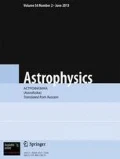Abstract
The paper is devoted to an investigation of the relationships between the classical Friedmann cosmology and the Dirac Hamiltonian approach to quantization of the universe, based on the simple but important example of a homogeneous universe filled with excitations of a scalar field. The method of gaugeless reduction is used to completely separate the sector of physical variables from the purely gauge sector, making it possible to find the relationship between cosmological observables in the Friedmann — Einstein sense and observables of the Dirac Hamiltonian formalism in the Narlikar conformai reference frame. Gaugeless reduction enabled us to establish that in the process of reduction, one of the variables of the nonphysical sector is converted into an invariant time parameter and cannot be treated as a dynamical variable in either the functional or the operator approach to quantization. It is shown that in this conversion of a variable into a time parameter, the Hartle-Hawking functional integral is the reason why the wave function of the Wheeler—De Witt (WDW) equation cannot be normalized and why an infinite gauge factor arises. The gaugeless reduction provides a certain recipe for mathematical and physical interpretation of the WDW equation and wave functions, the use of which makes their relationship to observational cosmology clear and transparent. It is shown, in particular, how the WDW wave function describes the Friedmann evolution with respect to proper time.
Similar content being viewed by others
Literature Cited
P. A. M. Dirac,Proc. R. Soc.,A246, 333 (1958);Phys. Rev.,114, 924 (1959).
R. Arnowitt, S. Deser, and C. W. Misner,Phys. Rev. 117, 1595 (1960).
J. A. Wheeler, in:Batelle Recontres: 1967 Lectures in Mathematics and Physics, C. De Witt and J. A. Wheeler (eds.), W. A. Benjamin, New York (1968).
B. S. De Witt,Phys. Rev.,160, 1113 (1967).
L. D. Faddeev and V. N. Popov,Usp. Fiz. Nauk,111, 427 (1973).
M. P. Ryan, Jr., and L. C. Shapley,Homogeneous Relativistic Cosmologies, Princeton Series on Physics, Princeton Univ. Press., Princeton, N.J. (1975).
M. P. Ryan,Hamiltonian Cosmology, Lecture Notes in Physics, No. 13, Springer-Verlag, Berlin-Heidelberg-New York (1972).
S. A. Gogilidze, A. M. Khvedelidze, and V. N. Pervushin, “On admissible gauges for constrained systems,”JINRPreprint, E2-95-203 (1995);Preprint, ZU-TH-4/95, hep-th 9504154 (1995);Phys. Rev. D,53, 2160 (1996).
S. A. Gogilidze, A. M. Khvedelidze, and V. N. Pervushin,“On Abelization of first class constraints,”JINRPreprint, E2-95-131, hep-th 9504153 (1995);J. Math. Phys.,37, 1760 (1996).
A. A. Friedmann,Z. Phys.,10, 377 (1922).
J. V. Narlikar, in:Astrofizica e Cosmologia, Gravitazione, Quanti e Relativita, G. Barbera, Florence (1979).
K. P. Stanyukovich and V. N. Mel’nikov,Hydrodynamics, Fields, and Constants in the Theory of Gravitation [in Russian], Énergoizdat, Moscow (1973), p. 105.
P. A. M. Dirac, Lectures on Quantum Mechanics, Belfer Graduate School of Science, Yeshiva Univ., New York.
V. Pervushin, V. Papoyan, S. Gogilidze, et al.,Phys. Lett.,B365, 35 (1996).
V. Pervushin and T. Towmasjan,Int. J. Mod. Phys.,D4, No. 1, 105–113 (1995).
A. M. Khvedelidze, V. V. Papoyan, and V. N. Pervushin,Phys. Rev. D,51, 5654 (1995).
G. Lavrelashvili, V. A. Rubakow, and P. G. Tinyakov, in:Proceedings of the Fifth Seminar on Quantum Gravity,28 May–1 June 1990, M. A. Markov et al. (eds.), Moscow.
J. B. Hartle and S. W. Hawking,Phys. Rev. D,28 (1983).
S. A. Hayward,Phys. Rev. D,53, 5664 (1996).
Author information
Authors and Affiliations
Additional information
Translated from Astrofizika, Vol. 40, No. 2, pp. 303–321, April–June, 1997.
Rights and permissions
About this article
Cite this article
Palii, Y.P., Papoyan, V.V. & Pervushin, V.N. Status of physical observables of a friedmann universe in the classical and quantum hamiltonian formalisms. Astrophysics 40, 198–210 (1997). https://doi.org/10.1007/BF03036114
Received:
Accepted:
Issue Date:
DOI: https://doi.org/10.1007/BF03036114


